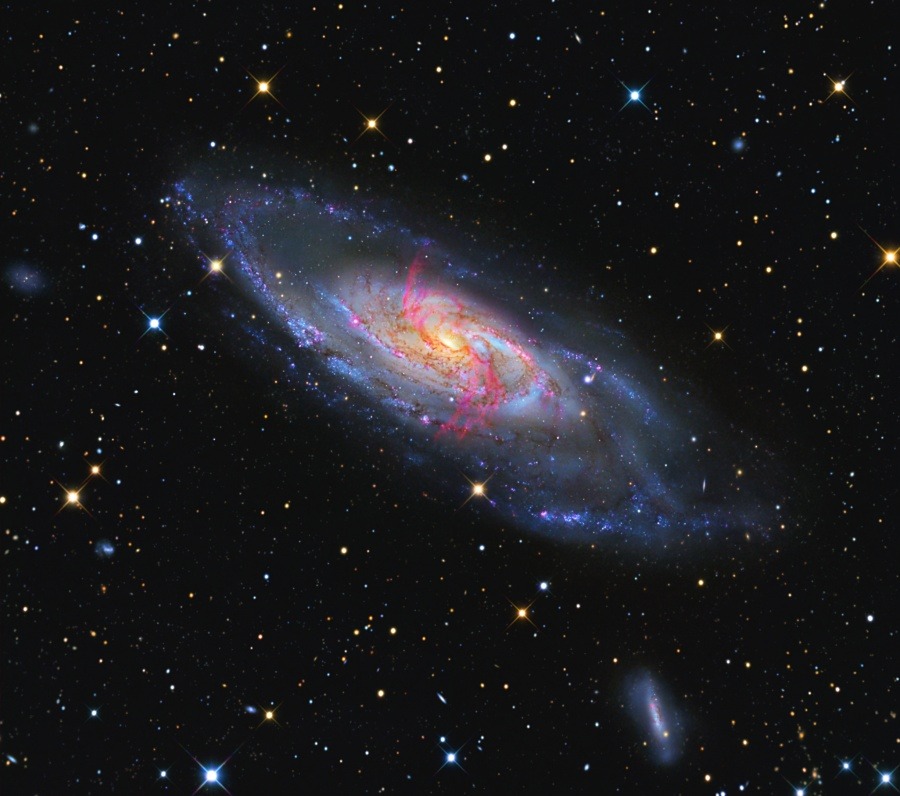http://en.wikipedia.org/wiki/Megamaser wrote:
<<A megamaser is a type of astrophysical maser, which is a naturally occurring source of stimulated spectral line emission. Megamasers are distinguished from astrophysical masers by their large isotropic luminosity. Megamasers have typical luminosities of 10
3 solar luminosities (L
☉), which is 100 million times brighter than masers in the Milky Way, hence the prefix mega. Most known extragalactic masers are megamasers, and the majority of megamasers are hydroxyl (OH) megamasers, meaning the spectral line being amplified is one due to a transition in the hydroxyl molecule. There are known megamasers for three other molecules: water (H
2O), formaldehyde (H
2CO), and methine (CH).
Hydroxyl megamasers were the first type of megamaser discovered. The first hydroxyl megamaser was found in 1982 in Arp 220, which is the nearest
ultraluminous infrared galaxy to the Milky Way. All subsequent OH megamasers that have been discovered are also in luminous infrared galaxies. Most luminous infrared galaxies have recently merged or interacted with another galaxy, and are undergoing a burst of star formation.
The population inversion in hydroxyl molecules is produced by far infrared radiation that results from absorption and re-emission of light from forming stars by surrounding interstellar dust. Zeeman splitting of hydroxyl megamaser lines may be used to measure magnetic fields in the masing regions, and this application represents the first detection of Zeeman splitting in a galaxy other than the Milky Way.
Water megamasers are found primarily associated with active galactic nuclei. Water maser emission is observed primarily at 22 GHz, due to a transition between rotational energy levels in the water molecule. The upper state is at an energy corresponding to 643 Kelvin about the ground state, and populating this upper maser level requires number densities of molecular hydrogen of order 10
8 cm−
3 or greater and temperatures of at least 300 Kelvin. The water molecule comes in to thermal equilibrium at molecular hydrogen number densities of roughly 10
11 cm−
3, so this places an upper limit on the number density in a water masing region.
Water masers emission has been successfully modeling by masers occurring behind shock waves propagating through dense regions in the interstellar medium. These shocks produce the high number densities and temperatures (relative to typical conditions in the interstellar medium) required for maser emission, and are successful in explaining observed masers.
Water megamasers may be used to provide accurate distance determinations to distant galaxies. Assuming a Keplerian orbit, measuring the centripetal acceleration and velocity of water maser spots yields the physical diameter subtended by the maser spots. By then comparing the physical radius to the angular diameter measured on the sky, the distance to the maser may be determined. This method is effective with water megamasers because they occur in a small region around an AGN, and have narrow linewidths. This method of measuring distances is being used to provide an independent measure of the Hubble constant that does not rely upon use of standard candles. The method is limited, however, by the small number of water megamasers known at distances within the Hubble flow. This distance measurement also provides a measurement of the mass of the central object, which in this case is a super massive black hole. Black hole mass measurements using water megamasers is the most accurate method of mass determination for black holes in galaxies other than the Milky Way. The black hole masses that are measured are consistent with the
M-sigma relation.>>
 The Arms of M106
The Arms of M106

